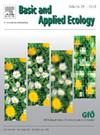人类压力可以减少遗传多样性和提高营养地位:一个节肢动物案例研究
IF 3.5
2区 环境科学与生态学
Q2 ECOLOGY
引用次数: 0
摘要
城市和农业区覆盖的土地越来越多,动物栖息地日益恶化。到目前为止,关于城市化的研究有限,关于农业影响的研究就更少了。为了了解这种整体的人类压力(即流源性)是如何影响节肢动物的,我们选择了跨学科的方法,通过研究蜘蛛Araneus diadematus和Nuctenea umbratica以及蚂蚁Formica fuscocinerea的遗传多样性和营养地位。在中欧一个绿化环境的中型城市中,在50个500 × 500 m平方米的样地中,每个物种采集5个标本。首先,利用新开发的微卫星进行遗传分析,揭示了异流性对双足黑蜘蛛的显著影响,即遗传多样性降低。其次,与之相似的是,稳定同位素δ15N随血红蛋白的增加而增加,这可能是由于食物谱发生了重大变化。因此,我们发现血源性对节肢动物有负面影响。我们相信我们的发现与城市规划有关,特别是考虑到对更大、更城市化的城市和更不脆弱的生物的影响更大。本文章由计算机程序翻译,如有差异,请以英文原文为准。
Human pressure can reduce genetic diversity and elevate trophic position: an arthropod case study
Urban and agricultural areas are covering ever more land, deteriorating animal habitats. So far, there exist a limited number of studies on urbanisation and even fewer studies on the impact of agriculture. To find out how this overall human pressure, that is, hemeroby, affects arthropods, we chose an interdisciplinary approach by studying genetic diversity and trophic position of the spiders Araneus diadematus and Nuctenea umbratica and the ant Formica fuscocinerea. We collected five specimens per species from fifty 500 × 500 m square plots in a medium-sized Central-European city with green surroundings. Firstly, genetic analyses using newly developed microsatellites revealed a significant effect of hemeroby on Araneus diadematus, that is, reduced genetic diversity. Secondly, likewise in Araneus diadematus, the stable isotope δ15N increased with hemeroby, possibly due to a major food-spectrum change. Thus, we found that hemeroby can negatively impact arthropods. We believe our findings are relevant to urban planning, particularly given that even stronger effects can be expected for larger and more urbanised cities and in less vagile organisms.
求助全文
通过发布文献求助,成功后即可免费获取论文全文。
去求助
来源期刊

Basic and Applied Ecology
环境科学-生态学
CiteScore
6.90
自引率
5.30%
发文量
103
审稿时长
10.6 weeks
期刊介绍:
Basic and Applied Ecology provides a forum in which significant advances and ideas can be rapidly communicated to a wide audience. Basic and Applied Ecology publishes original contributions, perspectives and reviews from all areas of basic and applied ecology. Ecologists from all countries are invited to publish ecological research of international interest in its pages. There is no bias with regard to taxon or geographical area.
 求助内容:
求助内容: 应助结果提醒方式:
应助结果提醒方式:


